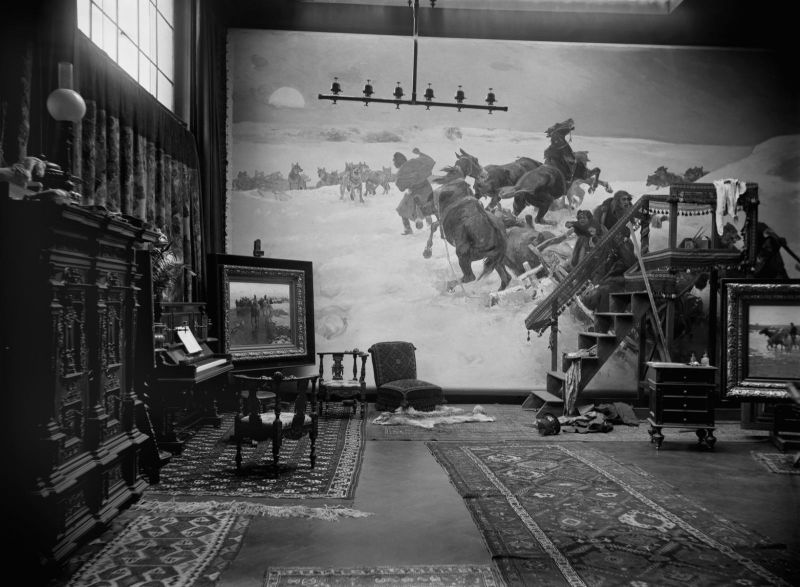Ateliers of Polish painters in Munich ca. 1890
Mediathek Sorted
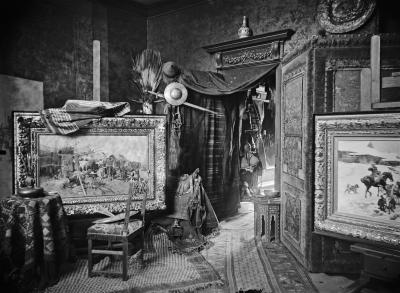
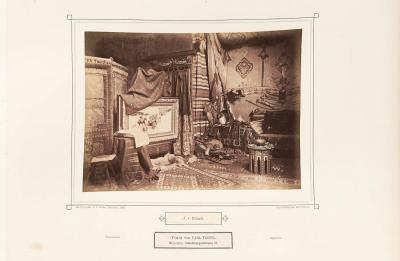

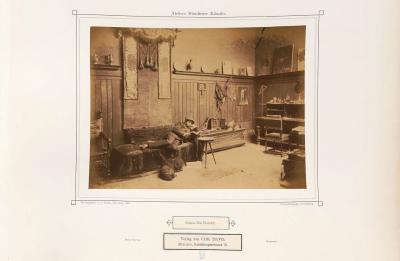






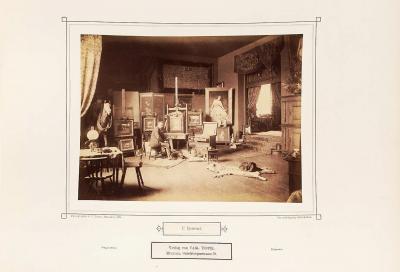




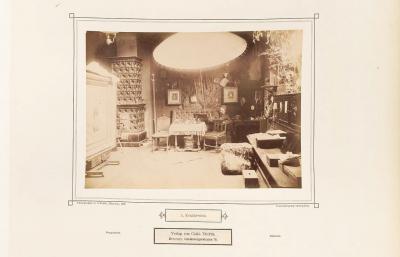


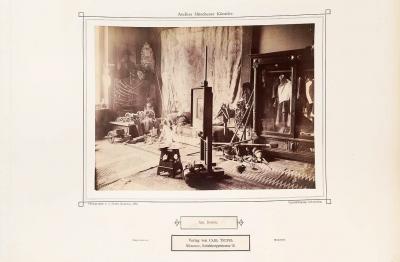



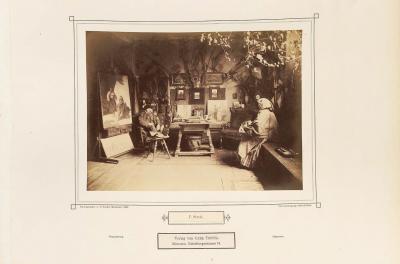

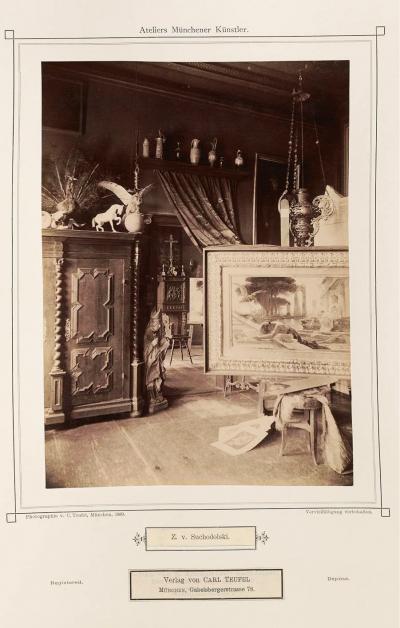

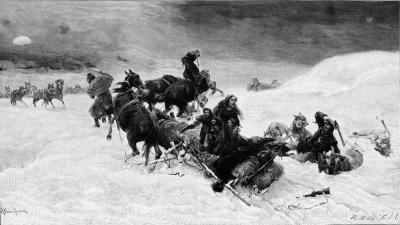


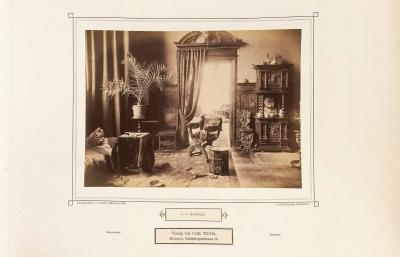
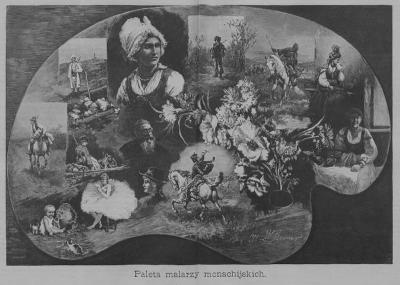


The painting looks like a sketch used for practice but the drawings lined up on the mantelpiece and the smaller to medium-sized paintings evidence the fact that the artist was already an accomplished painter. As he is not listed in any Munich address book, it is possible that Brandt or another member of the Polish colony recommended him to the photographer. The atelier seems to have been improvised and it is to be assumed that the artist had his sleeping area behind the curtain hung on a bamboo pole. However, it is still picturesque enough for the photograph to be of interest. Based on Brandt’s model, the artist had gathered together saddles and bridles, uniform caps, pistols and sabres, antlers and a target, which he had gone to some trouble to arrange in the small room. The family photos lined up on a shelf and on the table underneath also indicate that the artist didn’t just work here, he also lived here. In 1893, he exhibited at the Annual Exhibition in the Glaspalast just one, showing portraits of people on horseback, these being “Lieutenant Colonel Baron v. R.” and a “Captain von F.”. In the catalogue, his address is listed as Heßstraße 37 in Maxvorstadt.[120] In 1895, he went to Berlin to work with Kossak on creating historical panoramas in his atelier, but returned to Munich time and again to visit Brandt.
With the exception of Pułaski, all the Polish artists that Teufel had selected from 1889 for his atelier photographs had already been living in Munich for years or even decades. Brandt, Wierusz-Kowalski, Kozakiewicz, Streitt, Rosen, Czachórski and Ejsmond had already come to Munich in the sixties and seventies, Suchodolski, Buchbinder and Jasiński arrived between 1880 and 1885. Publicly they formed, to all intents and purposes, the core group of the Polish artists colony which was named time and again in contemporary publications with a changing membership and with the addition of additional painters. In his discourse about the Munich School of Painting published in 1887, Adolf Rosenberg explicitly mentioned the existence of the “Polish Colony” and named Brandt, Wierusz-Kowalski, Czachórski and Kozakiewicz, but also the late Maksymilian Gierymski (1846-1874)[121], Jan Chełmiński (1851-1925)[122], who was already living in New York, and Fałat and Szerner, who were already working in Berlin, as its most important members.[123]
In his “History of Munich Art in the Nineteenth Century”, Friedrich Pecht acknowledged Brandt, Wierusz-Kowalski, Kozakiewicz, Czachórski, Suchodolski, Buchbinder, and Gierymski, Kurella and Włodzimierz Łoś (Waldemar Los, 1849-1888), who lived in Munich[124], Chełmiński and Świeszewski, who had worked in Munich to the end of his life in 1895 and who had already worked on the “Album of Polish Artists” (see PDF) in 1876. In November 1887, the Munich magazine Kunst für alle depicted an artist’s palette, which went by the title “The Poles in Munich” and which Brandt, Wierusz-Kowalski, Rosen, Buchbinder, Ejsmond, Szerner, Fałat and Bohdan Kleczyński (1851/52-1920), who had worked in Munich until 1888[125], had each painted with motifs that were typical to them.[126] In 1890, the Warsaw magazine Tygodnik Ilustrowany showed another painted palette entitled “Paleta malarzy monachijskich/Palette of Munich Artists” (Fig. 23) with motifs from Brandt, Wierusz-Kowalski, Rosen, Streitt, Kozakiewicz, Czachórski, Buchbinder, Ejsmond as well as Szerner, Aleksander Gierymski and the Munich-based painters Wacław Szymanowski (1859-1930), Józef Wodziński (1859-1918) and Michał Gorstkin Wywiórski (1861-1926).[127]
[120] Illustrated catalogue of the Munich Annual Exhibition of Artworks of all Nations in the Royal Glaspalaste, Munich 1892, page 64
[121] Detailed biography in the Encyclopaedia Polonica, https://www.porta-polonica.de/de/lexikon/gierymski-maksymilian
[122] Detailed biography in the Encyclopaedia Polonica, https://www.porta-polonica.de/de/lexikon/chelminski-jan
[123] Rosenberg 1887 (see literature), pages 46-48
[124] Detailed biography in the Encyclopaedia Polonica, https://www.porta-polonica.de/de/lexikon/los-wlodzimierz
[125] Detailed biography in the Encyclopaedia Polonica, https://www.porta-polonica.de/de/lexikon/kleczynski-bohdan
[126] see Fig. 15 in the online exhibition “Polish Artists in Munich 1828-1914“ in this portal, https://www.porta-polonica.de/de/atlas-der-erinnerungsorte/polnische-kuenstler-muenchen-1828-1914
[127] See Jednodniówka 2008, page XVII





















































































